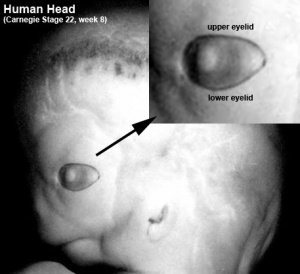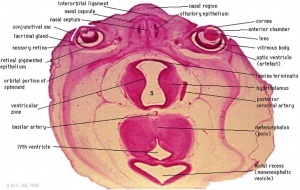Integumentary System - Eyelid Development: Difference between revisions
From Embryology
| Line 28: | Line 28: | ||
The following data is from a study of human embryonic carnegie stages.<ref><pubmed>7364662</pubmed></ref> | The following data is from a study of human embryonic carnegie stages.<ref><pubmed>7364662</pubmed></ref> | ||
* | * Stage 13 - By the end of the fourth week the optic vesicle lies close to the surface ectoderm. The surface ectoderm overlying the optic vesicle, in response to this contact, has thickened to form the lense placode. | ||
* | * Stage 14 - (about 32 days) the lens placode is indented by the lens pit. | ||
* | * Stage 15 - (about 33 days) the lens pit is closed. The lens vesicle and optic cup lie close to the surface ectoderm and appear to press against the surface. | ||
* | * Stage 16 - (37 days) Prior to the development of the eyelids, one small sulcus or groove forms above the eye (eyelid groove) and another below it. | ||
* | * Stages 17 - 19 - these grooves deepen, eyelid folds develop, first below, and then above, the eye. | ||
* | * Stages 19 - 22 - the eyelid folds develop into the eyelids and cover more of the eye as the palpebral fissure takes shape. The upper and the lower eyelids meet at the outer canthus in Stage 19. | ||
* | * Stage 20 - the inner canthus is established. | ||
* | * Stage 23 - closure of the eyelids is complete (shown as still open in the Kyoto embryo). | ||
==Abnormalities== | ==Abnormalities== | ||
Revision as of 09:17, 9 March 2011
Notice - Mark Hill
Currently this page is only a template and is being updated (this notice removed when completed).Introduction
Note that some species, such as rodents, are born with closed eyelids.
| Vision Links: vision | lens | retina | placode | extraocular muscle | cornea | eyelid | lacrima gland | vision abnormalities | Student project 1 | Student project 2 | Category:Vision | sensory | ||
|
Some Recent Findings
|
Human Eyelid Timeline
The following data is from a study of human embryonic carnegie stages.[4]
- Stage 13 - By the end of the fourth week the optic vesicle lies close to the surface ectoderm. The surface ectoderm overlying the optic vesicle, in response to this contact, has thickened to form the lense placode.
- Stage 14 - (about 32 days) the lens placode is indented by the lens pit.
- Stage 15 - (about 33 days) the lens pit is closed. The lens vesicle and optic cup lie close to the surface ectoderm and appear to press against the surface.
- Stage 16 - (37 days) Prior to the development of the eyelids, one small sulcus or groove forms above the eye (eyelid groove) and another below it.
- Stages 17 - 19 - these grooves deepen, eyelid folds develop, first below, and then above, the eye.
- Stages 19 - 22 - the eyelid folds develop into the eyelids and cover more of the eye as the palpebral fissure takes shape. The upper and the lower eyelids meet at the outer canthus in Stage 19.
- Stage 20 - the inner canthus is established.
- Stage 23 - closure of the eyelids is complete (shown as still open in the Kyoto embryo).
Abnormalities
Congenital upper eyelid ectopic cilia
References
Reviews
<pubmed>15558481</pubmed> <pubmed>6387662</pubmed>
Articles
<pubmed>15020428</pubmed> <pubmed>8270467</pubmed> <pubmed>7125235</pubmed>
Search PubMed
Search Pubmed: Eyelid Development
Glossary Links
- Glossary: A | B | C | D | E | F | G | H | I | J | K | L | M | N | O | P | Q | R | S | T | U | V | W | X | Y | Z | Numbers | Symbols | Term Link
Cite this page: Hill, M.A. (2024, April 16) Embryology Integumentary System - Eyelid Development. Retrieved from https://embryology.med.unsw.edu.au/embryology/index.php/Integumentary_System_-_Eyelid_Development
- © Dr Mark Hill 2024, UNSW Embryology ISBN: 978 0 7334 2609 4 - UNSW CRICOS Provider Code No. 00098G

